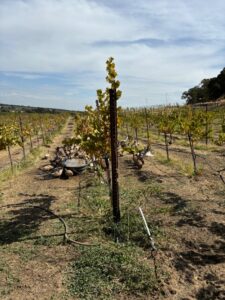
With its 7,000 acres of winegrapes valued at $100 million, hot, dry Yolo County is just one of the wine growing regions in California facing the challenges of climate change: heat and declining water supplies.
In Capay Valley, one small, family owned vineyard, Vitis & Ovis Farm, is taking on these challenges armed with the formidable knowledge of its internationally acclaimed agroecologically minded owners. Two generations of the Herren family, who hail from Switzerland, Ethiopia and the U.S., run the farm with the aid of 140 ducks.
While using ducks for weed control and fertilization is popular in South Africa vineyards, it is rare in the U.S.
The Herren’s hosted an event for growers and ranchers September 19 called “Adaptations to Climate Extremes” sponsored by the Community Alliance with Family Farms.
“The focus of the meeting was on how to manage under climate change, particularly water issues,” said farm co-owner Barbara Gemmell-Herren, who holds a Ph.D. from UC Davis and works internationally as an agroecology expert.
During the tour, the hosts showed the swales they constructed on their hillsides to manage water and replenish their well. Slowing runoff is key.

“We try to capture all the rainwater that may fall on our land so it doesn’t run off. It goes into the soil and… into the aquifer and recharges our well,” said Gemmell-Herren. “The idea is to make a landscape that really absorbs the water that falls so it’s more absorbent. You build what is called the soil sponge, rather than having hard soil that’s being compacted by tractors running over it or by livestock. We’re trying to minimize compaction as much as possible.”
That’s where their 140 ducks come in. They do what tractors otherwise do: Control weeds in the vine rows as well as under the vines. They also help manage the cover crop (by eating it) and fertilize the soil in both the vineyards and the fruit trees.
What do the ducks eat? “They are free range most of the time which will give them, usually, a lot of protein. They go out and forage a lot of insects as well as and it really adds nutritional quality and to the ducks’ happiness,” said Gemmell-Herren. “You just get better productivity, but you cannot solely depend on free range.” Regular feed supplements their diet.
The farm’s water conservation efforts help the ducks. “When it does rain, and the swales capture water, the ducks go down into those puddles,” she added.
Gisele, the Herren’s daughter who runs the day-to-day operations, tried having geese to protect the ducks, but they proved too aggressive and unpleasant. When hawks repeatedly ate ducks, she switched to larger varieties of ducks. Problem solved.
In addition to their role as vineyard workers, the ducks lay a lot of delicious duck eggs, which Gisele said are very popular at the farmers market for their flavor, richness and size.
Gemmell-Herren said their water conservation has brought positive results. “We feel like we’ve been really successful with that. Even during the drought, the levels in our well went up,” she said.
The farm welcomes visitors to see the property and their farming approach.











